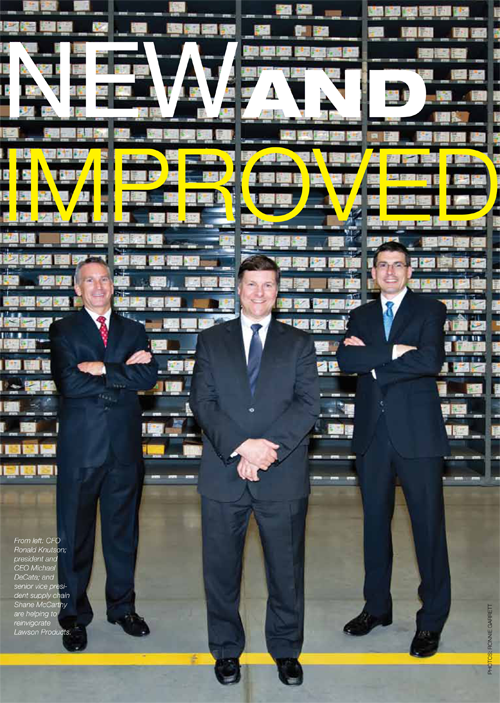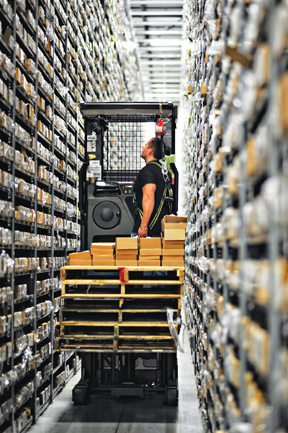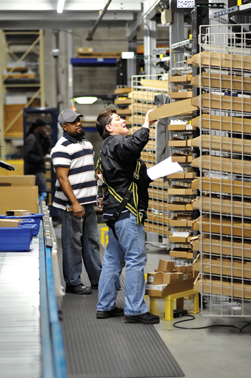New and improved

Above: From left: CFO Ronald Knutson; president and CEO Michael DeCata; and
senior vice president supply chain Shane McCarthy are helping to reinvigorate Lawson Products.
By Rich Vurva
A revitalization and reinvestment program returns MRO distributor Lawson Products to growth mode
After several years of declining sales and mounting losses, 2014 was the year that Lawson Products returned to a growth mode. The road back toward profitability was no small achievement.
It involved a change in management and major adjustments to its business model, including consolidating facilities, adopting Lean Six Sigma practices, transitioning the sales force from an independent sales agent model to company employees, investing in a new enterprise resource system and opening a state-of-the-art distribution center to improve operational efficiency.
The changes were necessary because the Chicago-based distributor of MRO consumable products had experienced a sales decline every year between 2007 and 2013. During that period, MRO sales declined from $374 million to $269 million. Profitability also suffered, as Lawson posted losses in six of the seven years.
The tide started to turn in 2011, when Lawson began a three-phase process focused on revitalization, reinvestment and growth.
The effort started with implementation of a new ERP system from SAP to replace Lawson’s outdated legacy system. During the transition period, productivity suffered while bugs were worked out and processes changed. The company also announced plans to relocate its corporate headquarters and to build a new packaging and distribution center. Each project required a major financial commitment.
In 2012, in order to improve sales force productivity, Lawson transitioned from an independent sales agent model to an employee sales team, which temporarily
resulted in a reduction in sales team members and a subsequent drop in sales. Lawson also launched a new e-commerce website and made a major investment in a new packaging and distribution center in McCook, Illinois, a Chicago suburb. All told, the company reported a loss of $62.6 million in 2012.
As 2012 came to a close, former president and CEO Thomas J. Neri retired, replaced by Michael G. DeCata, whose previous employment experienceincluded stints at Chefs Warehouse, a specialty food distributor, and United Rentals, W.W. Grainger and General Electric Co.
In his first public comments to investors when Lawson reported its 2012 financial results, DeCata pledged to continue to keep the focus on enhancing efficiencies and lowering operating costs, but also to begin to grow sales by developing under-served territories and increase the productivity of the sales force.
“Our customers consistently demonstrate that they believe in what we’re doing,” says DeCata. “They’re giving us more business, and they value our value proposition.”
 A new beginning
A new beginning
With a new top management team in place, new offices and a more modern distribution facility, the company culture started to change as well. Process improvements put into place started to have a positive impact not only on results, but in company morale, as employees recognized the investments being made to right the ship.
Senior management team members spend one day every month on the road with salespeople, calling on customers, filling bins and experiencing life in the trenches. The North American sales meeting, which had been abandoned in an early cost-cutting move, was reinstated in 2013.
Nearly two dozen people have completed training from APICs, the professional association for supply chain and operations management.
More than 70 people have received training in Lean Six Sigma principles to help them develop a more analytic approach to solving problems. New practices put into place in the distribution center, for example, include a daily huddle with each employee group to review metrics from the day before, such as the number of items picked, packaged and shipped.
“If someone has a bad production day, we can look into the root cause. Maybe it’s something as simple as a printer broke down,” explains Shane McCarthy, senior vice president of supply chain. “We’ve learned to remove obstacles so the workforce knows that they can bring up a problem as soon as it’s discovered. We’ve increased the communication and accountability for the people who want to be more action oriented.”
By the end of 2013, the changes implemented over the previous years had begun to positively impact the top and bottom line. Quarterly sales were trending upward, the sales team was growing larger, sales productivity began showing improvement, and the transition to the new distribution center was complete, which boosted fill rates and other productivity measures.
“Over the past two and a half years, our fill rates have improved by over 60 percent and our back orders have been reduced by more than 80 percent,” says DeCata.
The new SAP ERP system provides the management team with better insight into key variables that impact profitability, such as margins, daily sales, freight revenue, back orders and other metrics.
“It’s a daily performance scorecard that gives us visibility day in and day out so we can react very quickly,” explains Ronald Knutson, executive vice president and chief financial officer. The senior management team meets four times a week to review up to 140 variables that are updated daily. “If we start seeing a trend that is favorable or unfavorable, we can start pulling levers to affect that trend,” Knutson says.
 Focused on growth
Focused on growth
With a stronger foundation in place, Lawson is shifting its efforts now on growing the company in order to capture a larger share of an estimated $20 billion to $25 billion MRO consumables market.
It offers approximately 300,000 SKUs and maintains an inventory of about 50,000 products. About 60 percent of the company’s sales are private label products. Top selling items include fasteners; chemical such as adhesives, lubricants and cleaners; electrical components such as terminals and wire connectors, wiring devices, cable, cord and accessories. Most are the types of products stored in shelving units or bins that are replenished by Lawson salespeople on a scheduled basis.
“We’re selling items to customers that they use over and over again, so it gives us a level of predictability to anticipate the customer’s needs,” says DeCata. “From the customer’s perspective, if we do our job, they never call us. Whenever the mechanic reaches into the drawer, it’s there for them.”
Lawson hired 49 sales reps in 2013 and added about 100 more in 2014, bringing the total sales force to more than 900.
“We’re in the process of adding more sales reps. In 2015, it is our expectation that we’ll end the year with approximately 1,000 sales reps in total,” DeCata says.
Knutson adds that it typically takes 12 to 18 months after a salesperson is hired before the company sees a net improvement in earnings. “We’re adding sales reps every year and we recognize that the investment we’re making in salespeople now will benefit us in the future,” Knutson says.
A detailed study of the size of the MRO market at the county and zip code level across the United States has helped Lawson determine where it needs to hire more salespeople to capture additional market share. For example, the project revealed that the size of the Los Angeles, Calif., MRO market was approximately $3 billion, yet Lawson had only five reps in the area, revealing a clear need to add more reps in southern California.
Sales productivity has been boosted further by examining sales route density. For example, if the majority of a rep’s customers are within a 50-mile radius but one or two customers are 200 miles away, it may make sense to swap some accounts with another rep.
“As we add more sales reps, the reps themselves are reorganizing their territories so they get less drive time and more time servicing customers,” DeCata says.
Lawson has invested more in training sales reps in the types of products consumed in certain industries so they can identify new sales opportunities, and is arming reps with technologies, such as handheld devices that provide more visibility into product availability and pricing.
The investments in infrastructure and people have begun to produce tangible results in sales and profitability. In 2014, sales increased 6 percent to $285.7 million. Adjusted operating income increased by $3.9 million to $4.9 million.
Acquisitions on the horizon?
With growing sales and an improved balance sheet, DeCata says the company also hopes to uncover potential acquisition targets.
“We believe we’re an attractive company if you want to be acquired. We are now looking very closely at DNA match acquisitions,” he says. “We want to join with people who are in the same business we’re in but who recognize that we can do it more efficiently because of our inventory, our infrastructure and all the rest.”
Knutson estimates that Lawson can handle up to $100 million in additional sales without the need to add facilities. “That gives us tremendous flexibility to roll acquisitions into our existing infrastructure and be able to service more customers, have more sales reps, and take advantage of the dollars that we’ve invested into facilities such as McCook,” he says.
This article originally appeared in the March/April 2015 issue of Industrial Supply magazine. Copyright 2015, Direct Business Media.













